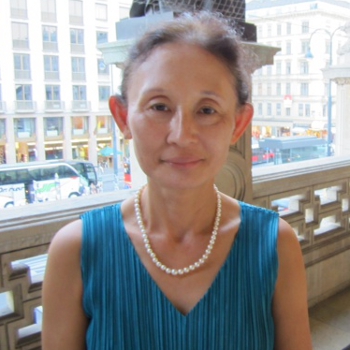Claus Guth’s 2016 production of Salome takes place in a men’s clothing store presided by Herod. The opening scene takes place in near darkness, with male mannequins coming to life as they become Narraboth, Page, the five Jews and soldiers. Salome, in a white nightdress, wanders around as if in a dream, soon joined by six younger versions of herself. Jochanaan appears buried in a pile of clothes on the floor, naked except for long johns. He is soon dressed in a suit by young Salomes, while the adult Salome sings his praises.
As the nightmarish scene gives way to daylight, and Herod and Herodias entertain their customers with a fashion show featuring the young Salomes. Herod is dressed in an identical outfit, complete with glasses, as Jochanaan, and it becomes clear that we are dealing with Salome as a disturbed and abused young woman for whom both Herod and Jochanaan represent abusive men. Salome’s Dance of Seven Veils features the seven Salomes recreating Salome’s childhood abuse by Herod (with Herodias’ acquiescence). As the accused parents look on, the adult Salome sings to a mannequin's head that resembling Herod. The opera ends as Salome leaves her parents’ store and her past behind, donning a coat handed to her by one of her younger selves, instead of being murdered by Herod’s soldiers as his final words command.
There was a single boo as the opera ended, likely directed towards the production, which is a radical reinterpretation of the story as Salome here is not a young woman whose awakening sexuality leads to violence but rather a victim of sexual abuse trying to escape her nightmare. There seems no rhyme or reason to move the palace to a clothing shop. The ensemble singers have to engage in bizarre and awkward gestures and movements as mannequins. While Salome’s obsession as a result of her childhood trauma is not far-fetched, Guth’s story of Salome’s struggle for freedom strays too far from the original story and the libretto.
This was unfortunate as the production was blessed with a commanding Salome. Catherine Naglestad as Salome dominated the evening from the moment she was on stage with the first note of a solo clarinet. She was convincing as a young woman bent on regaining her lost childhood and rebuilding her life. Naglestad's voice, clean, gleaming and rich, was a marvel as it rose high above the heavy orchestration with beauty and power. She was tireless in the demanding role and Salome’s last monologue, as the music became complex and dissonant, was one of the best I have experienced live. There was no strain, no screeching, but a wall of warm and thrilling sound coming from her. An amazing triumph.
The importance of Herod in the opera became clear in Guth’s production, and indeed Herod has a lot of notes to sing. Burkhard Ulrich was up to the task both in voice and acting. His Herod was a typical abusive man who has little awareness of the psychological damage he has inflicted on his young victim. Ulrich expressed Herod's bewildered confusion throughout, his voice ringing out with interesting colour and clear diction. Gabriele Schnaut, as Herodias, acted well as a helpless but still proud woman, but her voice, still resonant, was often wobbly. Samuel Youn boasted his powerful and strong voice but his singing lacked emotional nuance as the wise prophet.
Evan Rogister led a spirited and fast paced performance that brought out the rush and complex texture of Strauss’ early masterpiece. There were a few coordination issues with the singers, but perhaps a bigger issue was that the orchestra, especially the strings, sometimes drowned out the singers. Naglestad’s performance was even more remarkable as she held her own until the end and walked out as a strong heroine.


